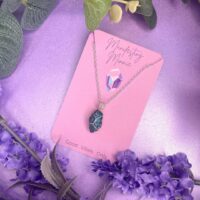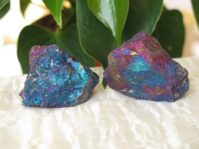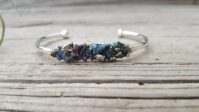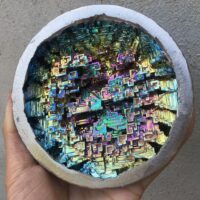Bornite is a unique colorful gem with interesting facts, mineralogy, and properties. Bornite is also known as Peacock Ore. Below is an outline of Peacock Ore’s history, mineralogy, and properties, among other interesting facts.
Peacock Ore History
Over centuries, Bornite has become known by several names, which evolved and changed courtesy of the scientists and experts involved. Johann Friedrich Henckel first included Peacock Ore with “kupferkies” (copper pyrites/Chalcopyrite) in 1725. This first occurrence was in Erzgebirge, Karlovy Vary Region Bohemia (currently known as the Czech Republic).
Later in 1747, Johann Gottschalk Wallerius assigned several multi-word Latin names. Subsequently, in 1802, Rene Just Haüy translated these names to variegated copper Ore and purple copper Ore. Previously, in 1791, Abraham Gottlieb Werner called it “buntkepfererz”. In 1832, Wilhelm Sulpice Beudant named it phillipsite.
Finally, in 1845, Wilhelm Karl von Haidinger renamed the stone Bornite as a tribute to Australian mineralogist and invertebrate zoologist Ignaz von Born (born as Born Ignác). However, there are no ancient traditions associated with Peacock Ore.
Peacock Ore Geological Properties (Mineralogy)
Peacock Ore is a copper sulfide mineral with a Cu5FeS4 chemical composition. Bornite (Peacock Ore) occurs in sedimentary, metamorphic, and igneous rocks). Peacock Ore’s mineable concentrations occur in contact metamorphic zones, hydrothermal veins, and enriched zones of several sulfide mineral deposits.
Bornite is commonly associated with Pyrite, Marcasite, and Chalcopyrite, which are all sulfide minerals. It also ranks up with other copper Ores such as Tetrahedrite, Cuprite, Digenite, Chalcocite, and Covellite. Additionally, small bornite traces can be found disseminated via carbonaceous shales and mafic igneous rocks.
Physical Traits / Appearance
Its color ranges from brown to black with a common purplish-bluish tarnish. It also has a reddish-bronze hue on freshly broken surfaces.
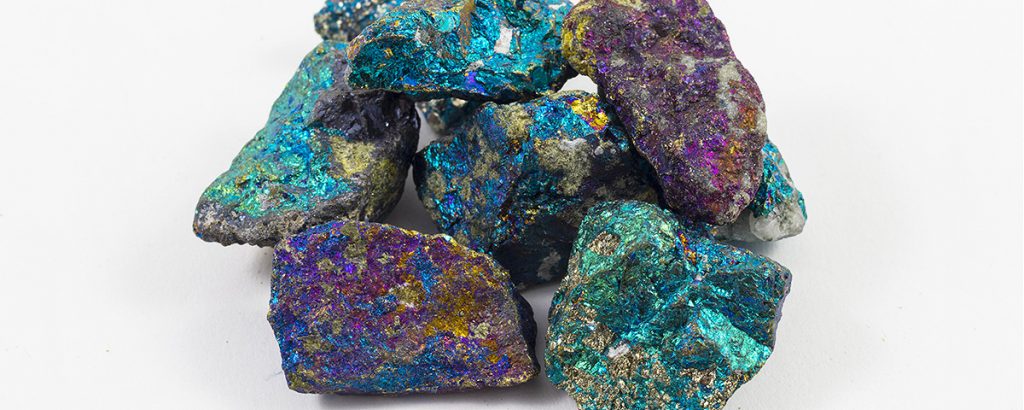
Bornite crystals are opaque. If found, bornite crystals appear as distorted cubes with curved faces. However, rarer types known as isometric crystals included distorted octahedrons and dodecahedrons. Generally, it is very hard to find Bornite in tiny crystals since they typically feature massive appearances.
Additionally, Bornite’s structure is not isometric at normal temperatures and is isometric at temperatures beyond 228 C, upon which the crystals will form. When cooling, the Bornite may alter structurally to a tetragonal structure yet still retain its isometric forms.
Bornite has a submetallic to metallic luster, conchoidal fracture, and a very poor octahedral cleavage. In addition, its hardness is 3 on the Mohs Scale of hardness. Its relatively low hardness makes it easy to separate Bornite from other minerals. Additionally, it has a gray-black streak.
Why is it Called Peacock Ore?
Bornite gets used in the mineral trade as a curiosity known as “Peacock Ore’. It is easily recognizable since it tarnishes to iridescent red, yellow, green, purple, and blue shades. Therefore, it obtains the Peacock Ore / purple copper Ore name after such iridescent hues.
Where is Bornite Mined?
Notable occurrences of Bornite include:
- The US (Arizona, Montana, Connecticut, and Colorado)
- The UK (Bristol, Cornwall
- Rhineland, Germany
- Mexico
- Peru
- Chile
- Bolivia
- Morocco
- South Africa
- Tsumeb, Namibia.
It is a fast-selling popular mineral specimen common in tourist shops, mineral shows, and museums. Upon proper treatment, Bornite is mOre visually appealing and sells fast.
Peacock Ore Metaphysical Properties
Are you having a hard time enjoying life and everything around you? Peacock Ore helps you realize that life and all its offerings are indeed enjoyable experiences that you ought to embrace. Bornite allows and pushes you to enjoy and be glad in your current situation whatsoever.
Additionally, Peacock Ore encourages you to align your emotions and thoughts calmly. By elevating your perceptive abilities, the stone helps you make conscious decisions based on calm emotions.
Bornite helps you handle stress and obstacles in your path to certain life goals. It does this by also helping you identify new opportunities and ways to accomplish your dreams and goals. Consider it a stone of success, and good luck on your way up the chain.
As a stone of joy and happiness, Bornite infuses in you positive energy, helping you identify what causes negativity in your life. Consequently, it enables you to eliminate such sources and their potential to reignite negativity.
Moreover, Peacock Ore helps to align your chakras and activate individual chakras. More importantly, healers and experts use Peacock Ore during the rebirthing process to guarantee effectiveness.
Peacock Ore Healing Properties and Benefits
Peacock Ore is a stone of happiness and relief; it relieves the body’s, mind’s, and heart’s troubles. It is an excellent healing crystal that channelizes positive energy and eliminates negative energy. Here is a breakdown of how you can use Bornite for proper healing.
Physical Healing
By placing or wearing it below the waist, Peacock Ore can help with blood circulation. It also regulates adrenaline flow in your body, especially if you tend to suffer from excessive acidity more than often. Place it near the navel or just above the waist to help relieve the symptoms.
Bornite helps to alleviate fever and swelling. Moreover, it maintains your body’s electrolyte balance and synchronizes its cellular structure and metabolism. Its high copper content helps to strengthen and support your body’s organs. It also acts as an anti-inflammatory for pain relief. It helps to prevent and treat cysts and tumors.
Spiritual Healing
Bornite is an excellent manifestation stone. It allows you to tap high-frequency energy into physical energy. The gemstone then uses this tapped energy to create abundance in your life. Peacock Ore’s frequency stimulates the creative flow of ideas and concepts. Additionally, Bornite helps you to embrace your natural abilities and potential.
Individuals use Peacock Ore in body layouts to establish harmony and balance polarities within their aura. Place the stone in your base chakra, the third chakra, or in your hands to anchor your aura within your body firmly. Ensure you align the stone properly to guarantee the effective functioning of your spiritual being in this physical realm.
Emotional Healing
Evidently, Peacock Ore boasts positive vibes and energies. These positive energies and vibes are ideal for emotional growth and healing. Peacock Ore helps to alleviate thoughts fixated on misfortune and despair.
The stone’s energy stimulates positive emotional energy that alleviates anxiety and frustrations. Additionally, it acts as a self mirror, helping to reveal, in due time, all the causes of your current emotional woes. Consequently, it helps you search and implement effective solutions to stabilize your emotional state.
Are you struggling with emotionally draining people around you? Peacock Ore helps you identify and pinpoint pretentious individuals in your life as well as every questionable aspect about them. As a result, the stone provides immense valuable insights into the things that bother you. Finally, Peacock Ore powers your emotional being and motivates you to take action by first overcoming fear.
Peacock Ore and Chakra
Peacock Ore is generally considered a Chakra stone. Peacock Ore colors vary with individual mineral specimens. Colors include green, blue, pink, and combinations of these colors that create a visual delight. The abundance of colors is what makes it known as a chakra stone.
At the very forefront, Peacock Ore is linked to the solar plexus chakra. As such, it can help you tap into high power since this chakra is often associated with power. However, as a chakra stone, Peacock Ore cleanses, balances, and aligns all your chakra centers collectively and individually. Subsequently, it aligns your entire physical body simultaneously with the ethereal and spiritual energy bodies.
Additionally, Bornite resonates well with the Third Eye, enabling you to discover your long-forgotten memories and knowledge. The stone helps you connect with ancient esoteric knowledge.
Meditation with Peacock Ore
Having trouble with your meditation process? Peacock Ore is an effective stone when it comes to meditation. The stone is popular for its ability to calm your mind before and during meditation. However, there are different ways you can use the Peacock Ore to meditate.
You can use Peacock Ore as a pendant during meditation, which undoubtedly increases its effectiveness due to its proximity to your body. Wearing it as a pendant is one of the most common usage methods of this stone.
Alternatively, you can choose to simply hold the stone in your hand or place it in your meditation space as you enter a meditative state. Regardless of the usage mode, Peacock Ore will work in the best way possible. It cleanses your energy during meditation, activates your chakras, and calms your mind.
Zodiac Connection
Peacock Ore is connected to the zodiac sign Capricorn and Taurus. It is also the secondary birthstone for Cancer. In addition, the stone is connected to all elements. Generally, while linked to individuals in the zodiac signs mentioned above, Peacock Ore may be considered a universal stone that favors individuals across the zodiac calendar.
Peacock Ore Value
Due to its abundance and availability, Peacock Ore has minimal value. It can be found in several mineral deposits globally and is not as hard to come by. However, as a specimen, Bornite’s value increases due to color, size, and uniqueness. It also gains a higher value if you have a rare crystal specimen.
The typical price of a Bornite sample specimen is $10. The larger the stone, the more value it gets. Additionally, the prettier the color, the more valuable the stone will be. The more expensive Bornite specimen typically have Chalcopyrite in them. In addition, the array of colors are visually appealing, and the larger-sized specimen typically fetch prices higher than $100.
How to Tell if A Peacock Ore is Real or Fake
One of the major drawbacks when acquiring precious stones is the possibility of buying fake gems instead of real ones. Unsuspecting buyers end up purchasing fake gems, which is usually a bad investment. Peacock Ore is one such gemstone susceptible to such unethical practices. How do you know if a Peacock Ore is real?
Generally, when buying Peacock Ore (Bornite) from a store, what you see there is ideally Chalcopyrite that has been treated chemically to show the beautiful color effect. Unfortunately, real precious Ore tarnishes black pretty quickly. However, treated Chalcopyrite tends to retain its beautiful colors for a while. Therefore, acid-treated Chalcopyrite is your ideal choice when shopping for Bornite.
To determine its realness, you may want to chip a small chip off for a more accurate test. The broken surface turns brown and tarnishes rapidly on a real Bornite. However, for the Chalcopyrite, the interior will be a shiny gold/silver, metallic-appearing surface. Expect it to remain that way.
Is Peacock Ore the Same as Chalcopyrite?
No, it is not. Peacock Ore (Bornite) is typically acid-treated Chalcopyrite. Once you expose Chalcopyrite to acid, its color palette changes to depict different colors. Ideally, the Peacock core is tarnished Bornite, which dulls naturally to show rainbow colors. Peacock Ore is what is mostly sold in shops and shows.
Is Peacock Ore (Bornite) Toxic?
As a copper Ore, Peacock Ore has high copper contents that measure up to 63%. Therefore, such high copper content, coupled with the availability of Sulphur, makes Peacock Ore very toxic. Exposure to its high toxicity will only be insignificant if you don’t ingest it and handle it with utmost care.
The stone is highly soluble in acids. Bornite’s toxicity is enough to rank it among the top highly toxic minerals. Reduce exposure to kids to avoid contamination. If possible, ensure it is not carelessly placed around your premises.
Bottom Line
Peacock Ore is child-like, playful, and innocent, with a soft and beautiful color appearance. Also known as Bornite, the stone first came into knowledge in 1725 in the Czech Republic. Between 1725 to 1845, Peacock Ore has undergone several name changes.
However, unlike other precious stones such as diamonds, Peacock Ore is not as valuable. This is mainly due to its easy availability. The stone is mined globally, from Africa to the US, Germany, and the UK. Due to its high supply, the demand is relatively low, which then affects its overall value.
Besides its beautiful appearance, Peacock Ore is loved for its healing properties and benefits. Proper caution is required when buying precious Ore to avoid buying fake Bornite. Most importantly, ensure you have an expert opinion to guide you during the purchase process.

